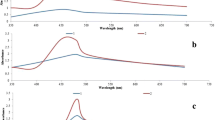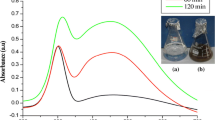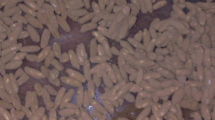Abstract
Fungi as such are known to be an effective mosquito control agent. In the present investigation, the effect of silver nanoparticles synthesized with Chrysosporium keratinophilum, Verticillium lecanii, and Fusarium oxysporum f.sp. pisi has been evaluated against the adult mosquito of filariasis vector Culex quinquefasciatus. The silver nanoparticles were characterized by using the UV–Vis spectrophotometer and X-ray diffraction techniques. The micrographs of silver nanoparticles were obtained by transmission electron microscope and scanning electron microscope. Elemental analysis on single particle was carried out by EDX analysis. The characterization study confirmed different shapes and sizes of silver nanoparticles. The efficacy test was performed at five different concentrations for a period of 24 h by the probit analysis. The C. quinquefasciatus has shown higher efficacy against the silver nanoparticles synthesized with C. keratinophilum and V. lecanii (lethal concentration (LC)50 0.19 and 0.4 μl/cm2; LC90 2.4 and 3.2 μl/cm2; and LC99 4.0 and 5.6 μl/cm2) after 22 h of exposure. While the silver nanoparticles synthesized with F. oxysporum f.sp. pisi were found to be less effective against the C. quinquefasciatus, the silver nanoparticles synthesized by C. keratinophilum and V. lecanii were found to be more effective than those generated with the help of F. oxysporum f.sp. pisi and C. quinquefasciatus. The use of fungus-mediated silver nanoparticles is a rapid, environmentally safer, and greener approach for vector control strategy and is adaptable globally.






Similar content being viewed by others
References
Abbott WS (1925) A method of computing the effectiveness of an insecticide. J Econ Entomol 18:265–266
Anitha TS, Palanivelu P (2011) Synthesis and structural characterization of polydisperse silver and multishaped gold nanoparticles using Fusarium oxysporum MTCC 284. Digest J Nanomater Biostr 6:1587–1595
Arjunan NK, Murugan K, Rejeeth C, Madhiyazhagan P, Donald R (2012) Green synthesis of silver nanoparticles for the control of mosquito vectors of malaria, filariasis and dengue. Vec Borne Zoo Dis 12:262–268
Barik TK, Kamaraju R, Gowawami A (2012) Silica nanoparticles: a potential new insecticide for mosquito vector control. Parasitol Res. doi:10.1007/s00436-012-2934-6
Borchert H, Shevchenko EV, Robert A, Mekis I, Kornowski A, Grübel G, Weller H (2005) Determination of nanocrystal sizes: a comparison of TEM, SAXS, and XRD studies of highly monodisperse CoPt3 particles. Langmuir 21:1931–1936
Finney DJ (1971) Probit analysis, 3rd edn. Cambridge University Press, Cambridge
Gardner JM, Pillai JS (1987) Tolypocladium cylindrosporum (Deuteromycotina: Moniliales), a fungal pathogen of the mosquito Aedes australis. Mycopathol 97:77–82
Huang CP, Juang CP, Morehart K, Allen L (1990) The removal of copper (II) from dilute aqueous solutions by Saccharomyces cerevisiae. Water Res 24:433–439
Jayaseelan C, Rahuman AA, Rajkumar G, Kirthi AV, Santoshkumar T, Marimuthu S, Bagavan A, Kamaraj C, Zahir AA, Elango G (2011) Synthesis of pediculocidal and larvicidal silver nanoparticles by leaf extract from heartleaf moonseed plant, Tinospora cordifilia Miers. Parasitol Res 109:185–194
Li G, He D, Qian Y, Guan B, Gao S, Cui Y, Yokoyama K, Wang L (2012) Fungus mediated green synthesis of silver nanoparticles using Aspergillus terreus. Int J Molecul Sci 13:466–476
Marimuthu S, Rahuman AA, Rajakumar G, Santhoshkumar T, Kirthi AV, Jayaseelan C, Bagavan A, Zahir AA, Elango G, Kamaraj C (2011) Evaluation of green synthesized green silver nanoparticles against parasites. Parasitol Res 108:1541–1549
Mukherjee P, Ahmad A, Mandal D, Senapati S, Sainkar SR, Khan MI, Parishcha R, Ajaykumar PV, Alam M, Kumar R, Sastry M (2001) Fungus-mediated synthesis of silver nanoparticles and their immobilization in the mycelia matrix: a novel biological approach to nanoparticle synthesis. Nano Lett 1:515–519
Patil HB, Borse SV, Patil DR, Patil UK, Patil HM (2011) Synthesis of silver nanoparticles by microbial method and their characterization. Arch Phy Res 2:153–158
Patil CD, Borase HP, Patil SV, Salunkhe RB, Salunkhe BK (2012) Larvicidal activity of silver nanoparticles synthesized using Pergularia daemia plant latex against Aedes aegypti and Anopheles stephensi and non target fish Poicillia reticulata. Parasitol Res. doi:10.1007/s00436-012-2867-0
Priyadarshini KA, Murugan K, Panneerselvam C, Ponarulselvam S, Hwang JS, Nicoletti M (2012) Biolarvicidal and pupicidal potential of silver nanoparticles synthesized using Euphorbia hitra against Anopheles stephensi Liston (Diptera: Culicidae). Parasitol Res. doi:10.1007/s00436-012-2924-8
Rajkumar G, Rahuman AA (2011) Larvicidal activity of synthesized silver nanoparticles using Eclipta prostrata leaf extract against filariasis and malaria vector. Acta Trop 118:196–203
Ramyadevi J, Jeyasubramanian K, Marikani A, Rajakumar G, Rahuman AA, Santhoshkumar T, Kirthi AV, Jayaseelan C, Marimuthu S (2011) Copper nanoparticles synthesized by polyol process used to control hematophagous parasites. Parasitol Res 109:1403–1415
Salunkhe RB, Patil SV, Patil CD, Salunke BK (2011) Larvicidal potential of silver nanoparticles synthesized using fungus Cochliobolus lunatus against Aedes aegypti (Linnaeus, 1762) and Anopheles stephensi Liston (Diptera; Culicidae). Parasitol Res 109:823–831
Santhoshkumar T, Rahuman AA, Rajakumar G, Marimuthu S, Bagavan A, Jayaseelan C, Zahir AA, Elango G, Kamaraj C (2011) Synthesis of silver nanoparticles using Nelumbo nucifera leaf extract and its larvicidal activity against malaria and filariasis vectors. Parasitol Res 108:693–702
Sap-Iam N, Homklinchan C, Larpudomlert R, Warisnoicharoen W, Sereemaspun A, Dubad ST (2010) UV irradiation-induced silver nanoparticles as mosquito larvicides. J App Sci 10:3132–3236
Sastry M, Absar AA, Khan MI, Kumar R (2003) Biosynthesis of metal nanoparticles using fungi and actinomycete. CurrSci 85:162–170
Silver S (2003) Bacterial silver resistance: molecular biology and uses and misuses of silver compounds. FEMS Microbiol Rev 27:341–353
Singh G, Prakash S (2011a) Efficacy of Trichophyton ajelloi and Lagenidium giganteum metabolites against mosquitoes after flash chromatography. ParasitolRes. doi:10.1007/s00436-011-2734-4
Singh G, Prakash S (2011b) Studies of fungal cultural filtrates against adult Culex quinquefasciatus (Diptera: Culicide) a vector of filariasis. J Parasitol Res. doi:10.1155/2011/147373
Singh G, Prakash S (2012a) Evalution of culture filtrates of Culicinomyces clavisporus: mycoadulticide for Culex quinquefasciatus, Aedes aegypti and Anopheles stephensi. Parasitol Res 110:267–272
Singh G, Prakash S (2012b) Lethal effects of Aspergillus niger against mosquitoes vector of filariasis, malaria and dengue: a liquid mycoadulticide. The Sci World J. doi:10.1100/2012/603984
Singh P, Raja RB (2011) Biological synthesis and characterization of silver nanoparticles using the fungus Trichoderma harzianum. Asian J Exp Biol Sci 2:600–605
Soni N, Prakash S (2011) Factors affecting the geometry of silver nanoparticles synthesis in Chrysosporium tropicum and Fusarium oxysporum. Am J Nanotechnol 2:112–121
Soni N, Prakash S (2012a) Efficacy of fungus mediated silver and gold nanoparticles against Aedes aegypti larvae. Parasitol Res 110:175–184
Soni N, Prakash S (2012b) Synthesis of gold nanoparticles by the fungus Aspergillus niger and its efficacy against mosquito larvae. Rep Parasitol 2:1–7
Vahabi K, Mansoori GA, Karimi S (2011) Biosynthesis of silver nanoparticles by fungus Trichoderma ressei. Insci J 1:65–79
World Health Organization (2006) Vector borne diseases in India. Report of a brainstorming session, 9 November 2006
World Health Organization (2010) Global program to eliminate lymphatic filariasis
Yang FL, Li XG, Zhu F, Lei CL (2009) Structural characterization of nanoparticles loaded with garlic essential oil and their insecticidal activity against Tribolium castaneum (Herbst) (Coleoptera: Tenebrionidae). J Agri Food Chem 57:10156–10162
Acknowledgments
We sincerely thank Prof. P.S. Satsangi Sahab, Chairman of Advisory Committee on Education, Dayalbagh Educational Institute. We thank to Prof. V.G. Das, Director, Dayalbagh Educational Institute for providing support and encouragements for the work. We also wish to thank DST-FIST (2003–2008) Government of India for facilitating equipment in our laboratory. We thank to UGC Major Research Project for providing financial support. We wish to thank Prof. Sahab Das, Department of Chemistry, Dayalbagh Educational Institute, for providing XRD facilities. We also thank Dr. Shashi Wadhawa for TEM (AIIMS, Delhi) and Dr. M. Shayam Prasad for SEM (NIO, Goa) for their generous help.
Author information
Authors and Affiliations
Corresponding author
Rights and permissions
About this article
Cite this article
Soni, N., Prakash, S. Fungal-mediated nano silver: an effective adulticide against mosquito. Parasitol Res 111, 2091–2098 (2012). https://doi.org/10.1007/s00436-012-3056-x
Received:
Accepted:
Published:
Issue Date:
DOI: https://doi.org/10.1007/s00436-012-3056-x




